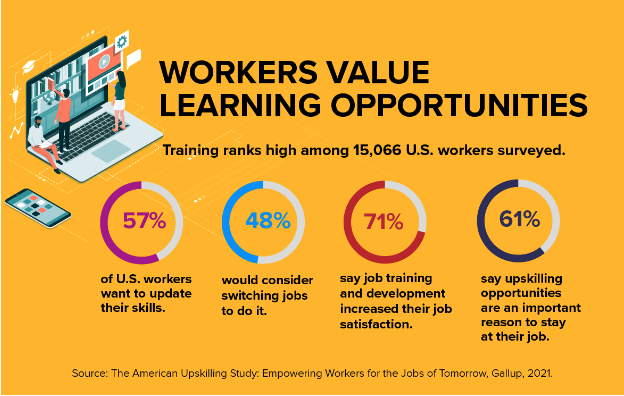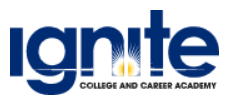“Education is now the #1 economic priority,” according to Don Gilman, CEO of Ignite College and Career Academy in Georgia. In the past, most economic development organizations focused their efforts on creating jobs and capital investment. Today, the pandemic’s “Great Resignation” coupled with the high level of Baby Boomers retiring has businesses struggling to fill jobs.
Chambers and EDOs are prioritizing talent attraction initiatives to help fill the 11.4 million job openings in the country. Education enhancements directly connect to talent attraction. Efforts such as upskilling, trade-focused high school academies, and promise programs can be differentiators when people choose a community where to live and work.

 Convergent worked with Ignite CCA in Sumter, Georgia, managing the quiet phase of their $1.75 million campaign to support skill development for students through dual-enrollment and work-based learning programs focused on strategically identified skill pathways. This effort was especially interesting as it was originally the brainchild of One Sumter Economic Development Foundation as, in the organization’s words, “perhaps the most ambitious undertaking One Sumter’s efforts around workforce development and education.”
One Sumter partnered with the county school district, local community college, and state university to develop the program. As they told the local paper, “Workforce development has many moving pieces, but the most obvious is training and preparing our residents to enter and move about effectively in industry. The greater our ability to do so, the greater our ability is in attracting the attention of potential industry as well as keep our current businesses staffed and growing.”
Convergent worked with Ignite CCA in Sumter, Georgia, managing the quiet phase of their $1.75 million campaign to support skill development for students through dual-enrollment and work-based learning programs focused on strategically identified skill pathways. This effort was especially interesting as it was originally the brainchild of One Sumter Economic Development Foundation as, in the organization’s words, “perhaps the most ambitious undertaking One Sumter’s efforts around workforce development and education.”
One Sumter partnered with the county school district, local community college, and state university to develop the program. As they told the local paper, “Workforce development has many moving pieces, but the most obvious is training and preparing our residents to enter and move about effectively in industry. The greater our ability to do so, the greater our ability is in attracting the attention of potential industry as well as keep our current businesses staffed and growing.”
 We recently completed our second capital campaign for The Greenwood Promise in Greenwood, South Carolina, an initiative driven by the Greenwood Partnership Alliance. We raised nearly $4.6 million in 2015 via an initial capital campaign that relied primarily on private sector funding to help cover in-state tuition and fees. On average, there are 750 graduating students per year who are eligible for The Greenwood Promise, and 30-35 percent of those students are anticipated to qualify for the Promise program initiative. That equates to approximately 225-262 students in Greenwood County receiving a post-secondary education, significantly increasing the community’s skilled workforce.
Studies have shown that Promise communities have lower high school dropout and juvenile crime rates, as well as increased tax revenue and average income levels. There are more than 200 Promise Programs in the country today. Many also include formulas to prorate the Promise’s financial support based on the length of time a family has lived in the community.
With a labor shortage in our country like we’ve never seen before, communities providing new and different education opportunities are offering an immediate and long-term solution to workforce development and talent attraction. Filling jobs today is key by marketing and funding initiatives that attract residents while ensuring that tomorrow’s workforce is educated, trained, and ready to work.
We recently completed our second capital campaign for The Greenwood Promise in Greenwood, South Carolina, an initiative driven by the Greenwood Partnership Alliance. We raised nearly $4.6 million in 2015 via an initial capital campaign that relied primarily on private sector funding to help cover in-state tuition and fees. On average, there are 750 graduating students per year who are eligible for The Greenwood Promise, and 30-35 percent of those students are anticipated to qualify for the Promise program initiative. That equates to approximately 225-262 students in Greenwood County receiving a post-secondary education, significantly increasing the community’s skilled workforce.
Studies have shown that Promise communities have lower high school dropout and juvenile crime rates, as well as increased tax revenue and average income levels. There are more than 200 Promise Programs in the country today. Many also include formulas to prorate the Promise’s financial support based on the length of time a family has lived in the community.
With a labor shortage in our country like we’ve never seen before, communities providing new and different education opportunities are offering an immediate and long-term solution to workforce development and talent attraction. Filling jobs today is key by marketing and funding initiatives that attract residents while ensuring that tomorrow’s workforce is educated, trained, and ready to work.
Learning and Development: Upskilling
In many cases job applicants or current employees may not possess the skill sets needed by employers. One way for a company to solve this issue–and be competitive in the talent attraction space–is to provide short-term, skill-specific training options. Skills training is one of the top perks younger workers look for in a new job, according to a 2021 Gallup survey conducted on behalf of Amazon. In that survey, 66 percent of workers ages 18-24 ranked learning new skills as the third-most important perk when evaluating new job opportunities, behind only health insurance and disability benefits.
Starting Earlier: College and Career Academies
First established more than 30 years ago, College and Career Academies (CCAs) enhance high schools to keep students engaged and launch them into individually relevant and strategically sound choices for college and/or career(s). Students in a CCA are enrolled in an interdisciplinary program of study that involves both career technical courses (typically one or two each year) and academic courses (typically three or four each year.). Convergent worked with Ignite CCA in Sumter, Georgia, managing the quiet phase of their $1.75 million campaign to support skill development for students through dual-enrollment and work-based learning programs focused on strategically identified skill pathways. This effort was especially interesting as it was originally the brainchild of One Sumter Economic Development Foundation as, in the organization’s words, “perhaps the most ambitious undertaking One Sumter’s efforts around workforce development and education.”
One Sumter partnered with the county school district, local community college, and state university to develop the program. As they told the local paper, “Workforce development has many moving pieces, but the most obvious is training and preparing our residents to enter and move about effectively in industry. The greater our ability to do so, the greater our ability is in attracting the attention of potential industry as well as keep our current businesses staffed and growing.”
Convergent worked with Ignite CCA in Sumter, Georgia, managing the quiet phase of their $1.75 million campaign to support skill development for students through dual-enrollment and work-based learning programs focused on strategically identified skill pathways. This effort was especially interesting as it was originally the brainchild of One Sumter Economic Development Foundation as, in the organization’s words, “perhaps the most ambitious undertaking One Sumter’s efforts around workforce development and education.”
One Sumter partnered with the county school district, local community college, and state university to develop the program. As they told the local paper, “Workforce development has many moving pieces, but the most obvious is training and preparing our residents to enter and move about effectively in industry. The greater our ability to do so, the greater our ability is in attracting the attention of potential industry as well as keep our current businesses staffed and growing.”
Education for All: Promise Programs
Promise programs are both an educational initiative and economic driver proven to attract families to communities where they are offered. With the high cost of college, many cannot afford the education needed to qualify for jobs in the community. A Promise program removes cost as an obstacle and essentially allows all high school graduates to go to college tuition-free. We recently completed our second capital campaign for The Greenwood Promise in Greenwood, South Carolina, an initiative driven by the Greenwood Partnership Alliance. We raised nearly $4.6 million in 2015 via an initial capital campaign that relied primarily on private sector funding to help cover in-state tuition and fees. On average, there are 750 graduating students per year who are eligible for The Greenwood Promise, and 30-35 percent of those students are anticipated to qualify for the Promise program initiative. That equates to approximately 225-262 students in Greenwood County receiving a post-secondary education, significantly increasing the community’s skilled workforce.
Studies have shown that Promise communities have lower high school dropout and juvenile crime rates, as well as increased tax revenue and average income levels. There are more than 200 Promise Programs in the country today. Many also include formulas to prorate the Promise’s financial support based on the length of time a family has lived in the community.
With a labor shortage in our country like we’ve never seen before, communities providing new and different education opportunities are offering an immediate and long-term solution to workforce development and talent attraction. Filling jobs today is key by marketing and funding initiatives that attract residents while ensuring that tomorrow’s workforce is educated, trained, and ready to work.
We recently completed our second capital campaign for The Greenwood Promise in Greenwood, South Carolina, an initiative driven by the Greenwood Partnership Alliance. We raised nearly $4.6 million in 2015 via an initial capital campaign that relied primarily on private sector funding to help cover in-state tuition and fees. On average, there are 750 graduating students per year who are eligible for The Greenwood Promise, and 30-35 percent of those students are anticipated to qualify for the Promise program initiative. That equates to approximately 225-262 students in Greenwood County receiving a post-secondary education, significantly increasing the community’s skilled workforce.
Studies have shown that Promise communities have lower high school dropout and juvenile crime rates, as well as increased tax revenue and average income levels. There are more than 200 Promise Programs in the country today. Many also include formulas to prorate the Promise’s financial support based on the length of time a family has lived in the community.
With a labor shortage in our country like we’ve never seen before, communities providing new and different education opportunities are offering an immediate and long-term solution to workforce development and talent attraction. Filling jobs today is key by marketing and funding initiatives that attract residents while ensuring that tomorrow’s workforce is educated, trained, and ready to work. 





